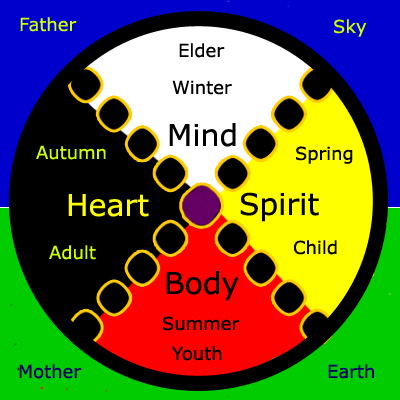The Four Directions
The holistic notion of body, mind, heart, and spirit is a time - honoured one for First Nations peoples but is somewhat of a novelty in mainstream society. It is however, a framework that is becoming more accepted as an important way to view the health of humans. More and more, this perception of people is being used across the board in mainstream health education and practice and in culturally appropriate programs and services.

This holistic view is just one example of the incredible knowledge and healing practices that were rejected during colonization. “In doing this Western cultures rejected the idea of a mind, body, emotions and spirit dialogue, returning to the ancestral voices for healing, looking to plants and animals for understanding and learning and the power of the spirit in healing and wellness. This rejection had the influence of sending traditional practices underground, and in some instances traditional healing practices were eliminated from the cultural vernacular altogether” (McCabe, .2008, p.144).
In contemporary times, renewed interest in the ancient teachings of Canada’s First Nations peoples is emerging. Tried and true methods of maintaining and restoring holistic balance of body, mind, heart, and spirit are resurfacing across the nation, even in mainstream health care. It is up to each teacher ato gain understanding and openness to these teachings to provide cultural safety to all First Nations people but to also care for all learners in a more aware, sensitive, competent, and insightful manner.
The illustration above demonstrates a visual representation of the teachings related to the four directions, showing the growth and development stages (child, youth, adult, elder); the seasons; the four directions; the body-mind-heart-spirit quaternity; including a purple centre that symbolizes the Self. There are many different models of the four directions teachings in First Nations cultures across Canada and the world at large; as well as newer modified renditions used by various healing groups including various New Age teachings. This version originates from the Anishanaabe, the original peoples of the Great Lakes area in Eastern Canada and the United States.
First Nations peoples have identified the importance of articulating their own definition of health such as the mind-body-heart-spirit paradigm. First Nations belief systems define health as a life lived in balance with other systems of which an individual is a part, such as environment, community and family.
Preparation
READ: McCabe, G. (2008). Mind, body, emotions and spirit: reaching to the ancestors for healing. Counseling Psychology Quarterly, 21(2), 143-152. .
VIEW AND LISTEN TO The Four Directions Teachings
(select Flash version for Multimedia experience; the transcripts are also available if you choose HTML or PDF formats):
Process
FOUR DIRECTIONS ANALYSIS
After watching The Four Directions Teachings Flash animation presentations, complete the Four Directions worksheet by writing a brief description of each component.
Developed by June Kaminski, 2013
|